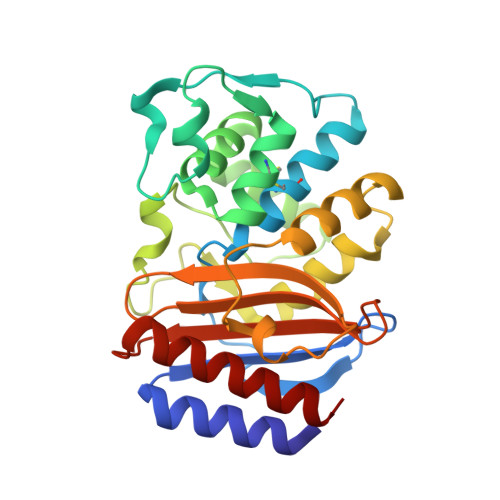Structure-based design guides the improved efficacy of deacylation transition state analogue inhibitors of TEM-1 beta-Lactamase(,).
Ness, S., Martin, R., Kindler, A.M., Paetzel, M., Gold, M., Jensen, S.E., Jones, J.B., Strynadka, N.C.(2000) Biochemistry 39: 5312-5321
- PubMed: 10820001
- DOI: https://doi.org/10.1021/bi992505b
- Primary Citation of Related Structures:
1ERM, 1ERO, 1ERQ - PubMed Abstract:
Transition state analogue boronic acid inhibitors mimicking the structures and interactions of good penicillin substrates for the TEM-1 beta-lactamase of Escherchia coli were designed using graphic analyses based on the enzyme's 1.7 A crystallographic structure. The synthesis of two of these transition state analogues, (1R)-1-phenylacetamido-2-(3-carboxyphenyl)ethylboronic acid (1) and (1R)-1-acetamido-2-(3-carboxy-2-hydroxyphenyl)ethylboronic acid (2), is reported. Kinetic measurements show that, as designed, compounds 1 and 2 are highly effective deacylation transition state analogue inhibitors of TEM-1 beta-lactamase, with inhibition constants of 5.9 and 13 nM, respectively. These values identify them as among the most potent competitive inhibitors yet reported for a beta-lactamase. The best inhibitor of the current series was (1R)-1-phenylacetamido-2-(3-carboxyphenyl)ethylboronic acid (1, K(I) = 5.9 nM), which resembles most closely the best known substrate of TEM-1, benzylpenicillin (penicillin G). The high-resolution crystallographic structures of these two inhibitors covalently bound to TEM-1 are also described. In addition to verifying the design features, these two structures show interesting and unanticipated changes in the active site area, including strong hydrogen bond formation, water displacement, and rearrangement of side chains. The structures provide new insights into the further design of this potent class of beta-lactamase inhibitors.
- Department of Biochemistry and Molecular Biology, University of British Columbia, 2146 Health Sciences Mall, Vancouver, British Columbia, Canada.
Organizational Affiliation:

















